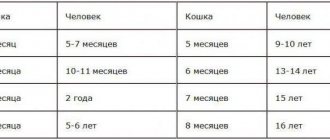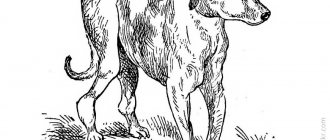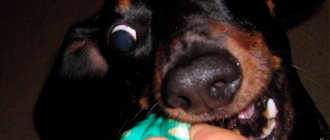Relationship between a dog's age and human years
Are you wondering how old your four-legged friend will be, in human age? To get the equivalent human age of a pet, you just need to multiply it by 7 or 6. This is approximately the case. Compare: dogs reach adulthood already at the age of two, when people need 18 years to do this. At 18 months, the dog will feel as fresh and cheerful as a person at 20.
On average, a dog lives up to 12 years. The figure depends on the breed, quality of life, genetics and other factors. Converted to human years, this would be approximately 64-77 years. When a dog turns 16, he feels like a full-fledged 90-year-old inhabitant of our planet.
There is another version. To obtain a dog's age similar to a human's, the multipliers must be gradually changed. For example, when a puppy is 2 months old, we multiply its age by 7, we get 14 human years. But upon reaching the age of six months, the puppy jumps sharply in development and its age is already equal to 5-6 human years, since the multiplication coefficient immediately changes to 10. 1 year is equal to 15 human years.
It is impossible to compare human and dog (or cat) ages with 100% objectivity, so we are content with those calculations that are quite realistic to make.
Why even know the dog's age?
In general, it won't be a big deal if you can't confirm the age of your new pet, especially if it's a mongrel that you just want to keep warm and cared for. And yet, you need to know at least the approximate number of months to vaccinate, drive away worms, feed him correctly, start training, etc. and so on. All of the above differs quite a lot depending on the age of the dog, which is why it would be worthwhile for a responsible owner to find out if he cares about making his ward’s life as comfortable as possible.
Below we will provide simple instructions that will help to accurately identify the age of a quadruped, and we will start with the smallest and end with adult perennial individuals.
Determining the age of the puppy
Finding out how many months a puppy is is not as difficult as an adult dog.
- A newborn puppy can be identified just by looking at the four-legged animal. His eyes are closed and there are no teeth at all. The puppy does not walk yet, he sleeps most of the time. The baby just squeaks quietly to attract her mother's attention. Using touch, he finds his mother's nipples and feeds only on breast milk. It will remain this way until about 2-3 weeks of life.
- After the first weeks, the puppy’s eyes gradually open, but he still cannot see fully. Gradually he distinguishes sounds and smells.
- From the first month of life, the baby begins to walk and explore the world around him. The exact age from a month to a year can be determined by the condition of his teeth. Up to 2 months, your pet’s baby teeth are just forming. Starting from the second month of life, baby teeth are replaced by molars. By the age of 1 year, the dog's molars should be fully formed. Between 6 and 12 months, puppies begin puberty, and girls go into heat.
- From 1 to 2 years old, a dog is considered a teenager. Dogs of large and medium breeds stop growing at this age. Large breed puppies continue to develop until they are 2 years old. Starting from the age of two, the pet is considered an adult.
How to determine the age of a puppy?
Published by Evgeny Furasiev on 10/11/2017
It happens that a puppy comes into the house from the street and you need to determine its age in order to know how to feed the baby, how to walk, and when to start training. This is in case you decide to keep the found puppy for yourself. And if you want to place it in good hands or find the owner, you even more need to determine its age in order to advertise your find.
The first step is a dental examination
Just like humans, dogs' teeth change once in their lifetime. Of course, this method gives approximate results, however, you can determine what age the puppy is. For example, baby teeth are very different from an adult dog's teeth. If there are fangs (we are talking about milk teeth), but there are no other teeth yet, the puppy is about 20 days old. The incisors appear at 30 days, the remaining milk teeth a little later. If the mouth has a full set of teeth, the puppy is 1.5-2 months old. Usually the puppy stays with its mother for up to 2 months, although it can get lost at any age.
If the puppy's front incisors have changed, we can say that he is already about 4 months old. It all depends on the breed and size of the dog. The middle incisors change at 5 months, new canines grow at the age of 6 months. By the age of one year, all the puppy’s teeth are replaced and they look white, healthy, strong with small tubercles. In large breeds, teeth grow and change more slowly, in small breeds faster. A one-year-old puppy should have a total of 42 teeth. Of these, 12 are incisors and 12 canines.
Second step – External inspection
A puppy's appearance can also indicate its age. There are some characteristics of certain breeds.
Let's say that from 4 weeks of age, Yorkshire Terrier puppies have golden hair roots on their heads. In general, the puppy’s appearance speaks for itself - babies mainly have undercoat on their bodies, molting occurs at about 4 months. Therefore, if the puppy’s fur is already hard and smooth, then your foundling is already more than 4 months old. The condition of the coat itself also indicates age. Very young puppies have smooth, soft, silky fur. From about six months, the wool becomes stiff and gets dirty faster.
However, if a dog is found on the street, then its fur will not always reliably indicate its age; it may be dirty, matted, because the puppy has been outside for a long time and has not eaten for a long time. Exhaustion and disease immediately affect the condition of the puppy’s coat; it becomes dull and lifeless.
Look also at his muscles and activity. Puppies are very active; they sleep less time than they move. The younger the puppy, the more active he is. A calmer period begins at 5 months, when the puppy can lie for a long time and watch what is happening around without getting up.
Another important factor in determining age is the eyes. They should be clear, clean, shiny. The expression in the eyes of puppies is always extremely curious, no matter what physical condition the puppy is in, he follows with his eyes everything that moves, he is very inquisitive.
Although it is best to show the puppy to a doctor, who will more accurately determine its age and tell you how to raise such a puppy.
Teeth
It is easy to determine the age of a dog by looking at its teeth. Veterinarians and dog handlers most accurately determine the age of an animal precisely by the condition of its teeth. Below is a complete table of the relationship between the number of teeth a dog has and its age.
| Age | Dental condition |
| From birth to 2-3 weeks | No teeth |
| 3-4 weeks | Milk hooks and fangs are just beginning to emerge |
| 4-5 weeks | Deciduous incisors appear |
| 5-7 weeks | The remaining teeth are emerging |
| 2 months | All baby teeth are there |
| 2-4 months | First, hooks and fangs are replaced with molars. |
| 3-5 months | Middle incisors change to molars |
| 4-6 months | Deciduous rear incisors are replaced by molars |
| Six months | Baby fangs are the last to fall out |
| 1 year | White teeth with tubercles |
| 2 years | On the lower toes, the tubercles are gradually worn away, but the teeth do not lose their beautiful appearance |
| 4 years | The upper tubercles wear away, the teeth lose their brightness |
| 5 years | Yellow plaque on teeth, possible formation of tartar |
| 6 years | Teeth are yellow, wear out, change shape |
| 8-10 years | The fangs are dull, the teeth are very worn. The enamel is clearly yellow |
| Over 10 years old | Teeth loosen and fall out, bite is disrupted |
How to understand how many months a puppy is
The easiest way to find out a puppy's age is to examine its teeth. This technique allows you to most accurately determine how old your pet is. Any dog’s teeth change only once in its life, just like a person’s. By the timing of the appearance of certain milk teeth, you can determine how many months the puppy is, and by the change of teeth, you can determine the age of a young dog.
The number of teeth of a puppy and an adult dog is different
At birth, puppies are toothless. The first teeth appear by 20-25 days of life. At the age of one month, the front row of incisors and canines are already fully formed. Before the puppy is two months old, all the remaining baby teeth grow in.
Molars are visually very easy to distinguish from milk teeth, which are much smaller and have sharper edges.
When the puppy is 3 months old, the process of replacing teeth begins. In this case, the milk ones fall out in a certain order and new ones grow in their place. By six months, all the teeth had already changed. At seven months, molars are formed in places where there were no dairy plants. This completes the process of tooth formation in a dog.
Teething in puppies
A healthy adult dog normally has 42 teeth, while puppies have only 28.
Table 1. Frequency of growth and replacement of teeth in a puppy
| Appearance of teeth | Age |
| Front row of baby teeth | 1 month |
| Lateral milk teeth | 2 month |
| Replacement of front incisors, hooks | 2-4 months |
| Replacement of lateral incisors, premolars | 3-5 months |
| Outskirts | 4-6 months |
| Fangs | 5-6 months |
| Growth of missing molars | 6-7 months |
Large breed puppies tend to have teeth that grow a little faster than small breed puppies.
The tooth replacement scheme is relevant provided that the bite is correct and the dog is in normal health. If the animal has any diseases or was kept in improper conditions, the rate of growth and replacement of teeth may differ from the norm.
Teeth arrangement
By external signs
Umbilical cord. The presence of an umbilical cord indicates that the puppy was recently born. If the umbilical cord is still fresh, the puppy is no more than a day old. On the 2nd day it dries up, and on the 3rd it is already separated from the dog’s belly.
Eyes. The puppy remains blind until 10-20 days of its life. The eyes should open before the first month. The cloudy and gray-blue color of the iris is characteristic of tsutsiki for up to a month. Clear eyes are characteristic of dogs one month and older. It is worth paying attention to the dog's gaze.
Ears. In the first days of life, the puppy does not hear anything. The baby will begin to recognize the first sounds only after the second week of life, and to fully hear by the month. As the puppy grows, its ears grow.
Weight. Obviously, a small puppy will weigh differently than an adult dog. There are tables of approximate weights for small and large breeds at all ages.
For dwarf breeds:
| Type | Newborn | 4 weeks | Six months | One and half year |
| Dwarf | 70-80 grams | 200-230 grams | 715-920 grams | 1-1.2 kg |
| Small | 90-100 grams | 270-320 grams | 1-1.2 kg | 1.4-1.9 kg |
| Average | 120-130 grams | 455-485 grams | 1.6-1.8 kg | 2.1-2.3 kg |
| Big | 145-170 grams | 540-650 grams | 1.9-2.2 kg | 2.4-3 kg |
For large and medium breeds, other parameters are presented. Knowing how much a dog of a particular breed should weigh at maturity, you can find out whether it has reached canine adulthood.
You need to be especially careful with giant breeds, as their dimensions develop very, very rapidly. One-month-old Labrador puppies weigh from 3.4 to 3.6 kg and grow to 30-40 within two years. The weight of an 11-month-old Rottweiler can already reach 50 kg.
Adult age
It is considered more difficult to accurately determine the number of years a dog is after three. The fact is that a dog’s age is determined mainly by its teeth. After the formation of all molars, the animal does not undergo any changes for a long time.
The dog develops fully during the second year of life. A dog that has reached not only sexual, but also behavioral maturity is considered fully mature. What distinguishes an adult dog from a puppy is a change in its behavior with others.
How to determine the physical maturity of a dog? Bitches reach puberty much earlier than males. At the age of 6-8 months, girls begin their first heat. If you notice an animal in heat, this means that she is definitely older than 8 months. It is important to monitor her all this time and prevent early pregnancy. Only a girl who has already reached 18 months of age is suitable for reproduction. Boys are also recommended to be crossed only after reaching the age of two.
A pet that has reached the age of seven can be considered elderly. Characteristic signs that the dog is old:
- The pet becomes less active, sleeps a lot, does not want to go for long walks;
- Gray hair on the face appears in a pet when it reaches 6-7 years of age. It also happens that gray hairs are found in younger individuals;
- Deterioration of hearing and vision. Partial deafness;
- Temperament changes, the animal becomes more aloof;
- Decreased appetite;
- There is no sexual desire and desire to play and meet other dogs;
- Frequent urge to urinate, problems with digestion.
The above signs are normal for an older dog. But if such oddities are noticed in the behavior of an animal that, according to other signs, has not reached the age of seven, this may indicate various kinds of diseases. Be carefull!
Dog age table
Most dogs live twelve to fifteen years, but there are also individuals aged twenty years. The real record holder was a Japanese dog named Pusuke - she lived twenty-six years and eight months. According to the Russian calculation system (one dog year is equal to seven human years), her age was estimated at 182 years. But Japanese specialists work according to a slightly different scheme - officially the dog is “drawn” to be one hundred and twenty-five years old. Interesting fact: until her last days, Puske felt just fine; the dog’s only health problems occurred when she was hit by a car several years before her death.
Experts distinguish several age groups in dogs:
- puppies (less than eight weeks old);
- young dogs (younger than eighteen months);
- adult dogs (over one and a half years old).
Medium dogs up to 12-25 kg
Medium breeds are considered to be those that reach 10 to 25 kg in weight at the age of 1.5-2 years. To determine the age of a dog, take a look at the table below. Here are the most popular breeds and their ideal weight at maturity (+- a couple of kilograms). To understand whether your dog has passed the 1.5 year mark, weigh him and compare him with the table.
| Breed name | Weight of bitches, kg | Male weight, kg |
| French Bulldog | 11,3-12 | 13-14 |
| Cocker Spaniel | 11,8-13 | 13-15 |
| Staffordshire Bull Terrier | 21 | 24-25 |
| Collie | 19-21 | 23,9-24,4 |
| Siberian Husky | 18,5-19,5 | 24-25 |
| Shar Pei | 18-20 | 24,9-26 |
Large from 25 kg
Large breeds are those whose weight ranges from 25-40 kg. Anyone who weighs more is considered a giant. The formation of such breeds as the Rottweiler or the German Shepherd completely ends when they reach two years of age. Puppies are already born large, weighing 3-4 kg.
| Breed name | Weight of bitches, kg | Male weight, kg |
| Golden Retriever | 30 | 33,7 |
| Labrador | 30-34 | 35,5-39,5 |
| German Shepherd | 28,4-30 | 35,9-40 |
| Boxer | 28,8-31 | 33,9-38 |
| Doberman | 28-33 | 39-44 |
| Rottweiler | 39,7 | 46,8-54 |
| Saint Bernard | 61-67 | 81-88 |
Tough
The expert will first look at the condition of the animal’s teeth. By the presence or absence of certain fangs, you can find out the age of the puppy. The age of an adult dog is determined by the presence of all molars and cusps on them. Above is the most complete table showing the correspondence between the years of an animal’s life and the approximate condition of its jaws.
The disadvantage of this method is that if the dog has a malocclusion or other jaw defects, diagnosis becomes difficult.
Ways to determine the age of a puppy
You can find out how long a puppy has lived in different ways, but this is most accurately determined by the presence and number of temporary and permanent teeth. The timing of their appearance and replacement indicates how many months the puppy has lived.
Puppies are born toothless. Teeth erupt 3 weeks after birth. By two months, all temporary teeth have grown. Their replacement begins after 3 months. It has a certain sequence:
- at 3 - 5 months the incisors are replaced;
- at 4 - 6 months permanent edges appear;
- At 6 - 7 months, fangs appear.
At the age of 7 months, molars begin to grow in places where temporary teeth are missing. After their appearance, the formation of the dental system ends.
Attention! The scheme is different if the puppy suffered from illness or was kept in unfavorable conditions
There are other signs of how to find out the age of a puppy. Knowing the stages of its development will help with this.
Kids
- The baby's umbilical cord falls off on the 3rd day.
- Puppies are born blind. Eyes begin to emerge on the 15th day of life. Their full expansion occurs 3 weeks after birth. Immediately after opening, the eyes are blue or gray. Permanent eye color appears only after six months of life.
- Puppies have their ears closed after birth. Puppies acquire the ability to hear only after 3 weeks. If the puppy belongs to a breed with erect ears, then they will stand up at 4 - 5 months.
- If the puppy is purebred, then its approximate date of birth can be determined by its weight.
According to other signs
By behavior. Little puppies love to be near their mother. They do not leave their mother, sleep, eat and play nearby, and puppies up to two weeks old cannot do anything on their own. Since a month they have been actively studying everything and walking around. From two months and older, the puppy is already running around the house with all his might and doing mischief here and there. By six months, small breeds begin puberty; large breeds mature by up to a year. Character is formed around 4-5 months.
Barking. The puppy begins to bark at 1.5-2 months of age. His voice is not so loud, but ringing and perky.
Reaction to sound. Puppies cannot fully hear until they are a month old. If the puppy does not respond to sound stimuli, either he is not 2 weeks to a month old, or he is deaf or has problems with his ears.
Briefly about the main thing
- You can find out the age of your pet yourself, without the help of a veterinarian.
- First of all, look at the teeth, since the condition of the teeth can most accurately tell how old the dog is.
- Don't rush to judge prematurely. To complete the picture, conduct a full examination of the dog. This way you can objectively assess the situation and make the most accurate conclusion about its age.
Have we answered your question fully enough? If not, write your question in the comments below and our specialist will answer it.
Did you like the article? Share it with your friends on social media. networks. This will help them get useful information and support our project.
Ways to find out the age of an adult dog
The most accurate way to determine the years lived is the condition of the teeth. After their final formation, they gradually age, change color and shape. Knowing how this happens, you can determine the age of a dog by its teeth. Over the course of their lives, their appearance changes:
- Young animals (less than 2 years old) have sharp teeth. Their distinctive feature is the presence of tubercles resembling a trefoil.
- By the second year of life, the projections become smaller, but the teeth remain white.
- By the fifth year, yellowness appears. The fangs become dull.
- After six years, the incisors become concave and the canines finally lose their sharpness. The yellowness intensifies. Some dogs develop tartar on their teeth.
- After 8 years of life, teeth darken and become light brown. The canines shorten, the hooks become oval in shape.
- At 10-11 years old, many dogs reach old age. Teeth become loose and fall out. Due to their incorrect location, the bite is disturbed.
Elderly dog
It is not always possible to determine how many years a dog has lived based on the condition of its teeth. There are several reasons for this discrepancy.
- An incorrectly formed bite is the main reason. With a scissor bite, the teeth wear down faster. If the jaws do not close completely, the hooks remain in good shape for a longer time.
- The appearance of early calcareous deposits in dogs of dwarf breeds. This results in loose teeth that are not appropriate for their age.
- Animal nutrition is of great importance . When hard food predominates, the teeth wear out faster. If soft food predominates, then limescale forms and crumbling begins.
- Dogs' tendency to chew on hard objects causes their teeth to wear out more quickly.
You can find out how old a dog is both by the condition of its teeth and by other signs.
The condition of its coat can tell a lot about the age of a four-legged friend. Young animals have soft fur. Gradually, the fur becomes coarser and gray hairs appear on it. The first gray hair appears on the chin, and later it increases. This sign is not accurate, because the condition of the coat is affected by:
- conditions of detention;
- food composition;
- breed of dog;
- genetic features.
Young and active
Eyes that are clear and shiny in youth become dull with age. Some dogs experience changes in eye pigmentation. Whether dark or bright, the color fades with age. Dark brown eyes become brown, blue eyes become gray. Only the color of the eyes with a light color does not change: hazel or pearl color.
Young individuals are active, their muscles are well developed. The older the dog, the weaker its muscles are, and the less active it becomes. Due to muscle weakness, posture is disturbed: a stooped back and a saggy belly appear. The animal is less mobile and prefers to lie down more.











